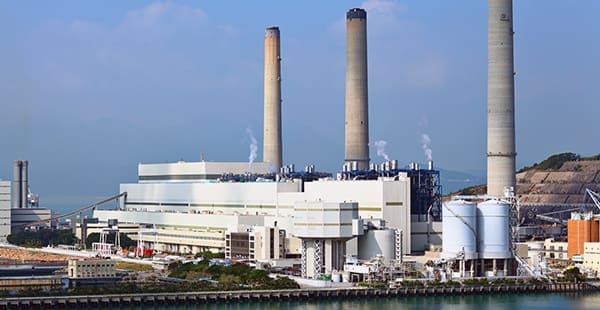How Was Asbestos Used at Power Plants?
Before the 1980s, asbestos-containing materials were frequently used at power plants. Asbestos was added to machinery to increase durability and heat resistance. Asbestos insulation also lined machines and pipes for fireproofing.
Power plant workers faced asbestos exposure while performing equipment maintenance and repairs. For example, workers would cut through insulation to fit it to the equipment. Often, this work released asbestos fibers into the air.
Frequent exposure to asbestos-containing products put power plant workers in danger. This exposure could lead to asbestos-related illnesses that show up later in life.
The U.S. has discontinued most asbestos products. But old asbestos materials may still be present at power plants and other jobsites. Understanding what products may contain asbestos can help workers reduce their exposure risk.
Notable Power Plants That Used Asbestos
Power plants across the U.S. often used asbestos products in their machinery. These power plants contracted asbestos companies to install insulation and other asbestos-containing materials.
Asbestos use at power plants across the country exposed many people to asbestos. Some power plants are still removing asbestos from their facilities.
Los Angeles Department of Water and Power (LADWP)
The LADWP is the largest municipal utility in the country. The facility serves more than four million California residents. It has approximately 11,500 employees.
In 2008, the U.S. Environmental Protection Agency (EPA) fined the LADWP $9,030. The fine happened after the LADWP demolished asbestos-containing structures without notifying the agency. Asbestos regulations require the EPA to be notified before a demolition.
Without the EPA’s help, the LADWP did not completely remove the asbestos from the building before demolition. The demolition may have released asbestos fibers into the air and put the public at risk.
Before the demolition, asbestos-containing materials at LADWP facilities risked workers’ health for years. The LADWP has faced many asbestos lawsuits by former workers and their families.
In 2019, the LADWP hired contractors to remove asbestos at four decommissioned generating units. Despite recent remediation efforts, machinery at the LADWP may still contain asbestos.
Pacific Gas and Electric Company (PG&E)
PG&E provides natural gas and electricity to millions of California households. PG&E is headquartered in San Francisco but has several power plant locations.
The company used various asbestos products at its power plants. These included asbestos insulation, turbines and boilers.
Former employees said airborne asbestos particles were often present at PG&E plants. Workers also had to work in tight quarters. This close environment often causes high concentrations of asbestos dust. PG&E frequently did not give workers adequate safety equipment to protect them from the asbestos dust.
Some PG&E workers developed asbestos-related diseases from working at the facilities. PG&E has faced many lawsuits stemming from work conditions, including asbestos lawsuits. The company filed for bankruptcy in 2001 and again in 2019.
Sometimes, bankrupt asbestos companies will create a trust fund to pay victims. PG&E does not have an asbestos trust fund, but the company has set up trust funds to pay other non-asbestos claims.
Pilgrim Nuclear Power Station
Pilgrim Nuclear Power Station was constructed in 1972 by Bechtel Corporation. At the time, it was the only nuclear power plant operating in Massachusetts. The power plant supplied power to Massachusetts homes for four decades.
When it was constructed, asbestos-containing materials were still being used at power plants. Bechtel Corporation was also a known user of asbestos products. Workers at the plant may have experienced asbestos exposure in the past.
In 2019, the power plant was decommissioned, and Holtec International bought it. When Holtec tried to remove asbestos after the purchase, it did not follow many safety procedures. The company has since faced violations, fines and a civil suit for its failures.
Other Power Plants That Caused Exposure
Other U.S. power companies with occupational exposure are listed by state below.
Alabama
- Barry Steam Plant
- Browns Ferry Nuclear Plant
- Childersburg Power Plant
- Colbert Steam Plant
- Farley Nuclear Power Plant
- Gaston Power Plant
- Gorgas Power Plant
- Greene County Steam Plant
- Miller Steam Plant
- Widows Creek Power Plant
Alaska
- Aurora Power
- Beluga Power Station
- Bernice Lake Powerhouse
- Chugach Power Plant
- Elmondorf Air Force Base – Powerhouse
- Golden Valley Electric Power Plant
- Matanuska Electric Association
- University of Alaska – Power Plant
Arizona
- Childs-Irving Power Plant
- Cholla Power Plant
- Ocotilla Power Plant
- Palo Verde Nuclear Generating Plant
- Saguaro Power Plant
- West Phoenix Power Plant
- Yucca Power Plant
Arkansas
- Arkansas Electric Cooperative Corp
- Arkansas Nuclear One Generating Station
- Carl E. Bailey Generating Station
- Flint Creek Power Plant
- Independence Steam Station
- John L. McClellan Generating Station
California
- Pacific Gas & Electric Company
- Pacific Gas & Electric Power Plant
- San Onofre Nuclear Generating Station
- Shasta Dam
- Southern California Edison
Colorado
- Arapahoe Power Plant
- Cameo Power Plant
- Cherokee Power Station
- Comanche Powerhouse
- Craig Power Station
- Fort St. Vrain Generating Station
- Hayden Power Plant
- Martin Drake Power Plant
- Nucla Power Station
- Pawnee Power Plant
- Rawhide Energy Station
- Ray D. Nixon Power Plant
- Valmont Powerhouse
- Zuni Power Plant
Connecticut
- Bridgeport Powerhouse
- Connecticut Yankee Atomic Power
- Devon Powerhouse
- Middletown Powerhouse
- Millstone Nuclear Power Plant
- Montville Powerhouse
- Norwalk Powerhouse
- Steel Point Powerhouse
Florida
- Anclote Power Plant
- Bartow Power Plant
- Big Bend Powerhouse
- Cape C. Fort Pierce Municipal Power Plant
- Cape Canaveral Power Plant
- Crist Power Plant
- Crystal River Nuclear Plant
- Fort Myers Power Plant
- Gannon/Culbreath Power Plant
- Hookers Power Plant
- Sholz Power Plant
- Smith Power Plant
- St. Lucie Nuclear Power Plant
- Turkey Point Nuclear Power Plant
Georgia
- Bowen Power Plant
- Kraft Power Plant
- Scherer Power Plant
- Vogtle Power Plant
Illinois
- Baldwin Power Plant
- Braidwood Nuclear Power Plant
- Clinton Power Station
- Dresden Nuclear Power Plant
- LaSalle Generating Station
- Quad Cities
- Zion Nuclear Power Station
Indiana
- Cayuga Power Plant
- F.B. Culley Generating Station
- R. Gallagher Generating Station
- Tanner’s Creek
- Wabash River Power Plant
Iowa
- Duane Arnold Nuclear Powerhouse
- Iowa Power and Light
- Sioux City Coal and Gas
- Tipton Power Plant
- Wolf Creek Generating Station
Kentucky
- Paradise Steam Plant
Louisiana
- Cajun Electric
- Little Gypsy Power Plant
- River Bend Power Plant
- R.S. Nelson Station Powerhouse
- Waterford Nuclear Power Plant
Maine
- Maine Yankee Nuclear Power Plant
Maryland
- Atomic Energy Commission
- Calvert Cliffs Nuclear Power Plant
Massachusetts
- Pilgrim Nuclear Power Plant
- Sithe Mystic Station Power Plant
Michigan
- Enrico Fermi Powerhouse
- Palisades Nuclear Power Plant
Minnesota
- Big Stone Lake Plant
- Hoot Lake Power Plant
- Monticello Nuclear Power Plant
- Prairie Island
Mississippi
- Grand Gulf Nuclear Power Plant
Missouri
- Callaway Nuclear Power Plant
Montana
- Colstrip Power Plant
- J.E. Corrette Steam Plant
- Lewis & Clark Power Plant
- Missoula Electric Cooperative
- Montana Power Company
Nebraska
- Canaday Station
- Cooper Nuclear Power Plant
- Cuming County Public Power
- Fort Calhoun Nuclear Power Plant
- Gerald Gentleman Station
- Hallam Nuclear Power Facility
- Omaha Public Power
- Sheldon Station
Nevada
- Beowawe Power Plant
- Brady Power Plant
- Clark Station
- Desert Peak Power Plant
- Dixie Valley Power Plant
- Empire Farms Power Plant
- Fort Churchill Generating Station
- Pinon Pine Power Plant
- Reid Gardner Station
- Soda Lake I & II
- Steamboat Power Plants
- Tracy Generating Station
- Valmy Generating Station
- Wabuska
New Hampshire
- Dover Gas Plant
- Exeter Gas Plant
- Merrimack Station Powerhouse
- Newington Power Plant
- Schiller Station Powerhouse
- Seabrook Nuclear Power Station
New Jersey
- Hope Creek Nuclear Power Plant
- Oyster Creek
- Salem Nuclear Power Plant
- New Mexico
- Four Corners Powerhouse
- United Nuclear Corporation
New York
- Arthur Kill Powerhouse
- Astoria Powerhouse
- Caithness Power Plant
- Charles Poletti Power Project
- Fitzpatrick Nuclear Power Plant
- Flynn Power Plant
- Ginna Nuclear Plant
- Indian Point Nuclear Power Plant
- Indian Point Nuclear Power Plant 2
- Nine Mile Point Nuclear Station
North Carolina
- Brunswick Nuclear Power Plant
- McGuire Nuclear Power Plant
- Shearon Harris Generating Station
North Dakota
- Coyote Power Station
Ohio
- Beckjord Power Plant
- Cardinal Power Plant
- Conesville Power Plant
- Davis-Besse Nuclear Power Plant
- Muskingum Power Station
- Perry Nuclear Power Plant
- Sammis Power Station
Oklahoma
- Ponca City Municipal Electric System
Pennsylvania
- Peach Bottom Nuclear Power Plant
- Susquehanna Power Station
- Three Mile Island
South Carolina
- Catawba Nuclear Plant
Vermont
- Vermont Yankee Power Plant
Wisconsin
- Alliant Energy
Who Is at Risk of Exposure at Power Plants?
Power plant workers risked occupational asbestos exposure from contact with machinery. Power plant machinery used asbestos products to protect equipment from high heat.
One study about power plant workers found metal workers had higher asbestos exposure risks. Metal workers often work in high-heat environments. The plant owners may have installed asbestos products to protect workers from hot machinery.
Many other workers also faced asbestos exposure while maintaining and repairing machines. These tasks could disturb asbestos insulation. As the machinery aged, equipment wear and tear also may have disturbed and released asbestos.
When asbestos is disturbed, its fibers may become airborne. Workers can then ingest or inhale these fibers. Frequent exposure increases the risk of developing an asbestos-related disease, such as mesothelioma. But no amount of asbestos exposure is safe.
Power plant workers wear heat-resistant clothing to protect themselves while on the jobsite. In the past, this protective clothing was often made with asbestos. Asbestos-containing protective clothing may include:
- Aprons
- Coats
- Gloves
- Masks
- Pants
The asbestos clothing protected employees from hot machinery and fire. But the clothing also released asbestos fibers, increasing the risk of exposing workers.
Secondary Asbestos Exposure From Power Plants
It was also common for workers to bring home asbestos dust on their clothing. This caused family members to experience secondary asbestos exposure.
Often, power plant workers and their families were unaware asbestos exposure occurred. Many people only learned of their exposure after an asbestos-related diagnosis.
Occupational and secondary exposures continue to put people at risk. After exposure, people can develop mesothelioma, lung cancer, asbestosis and other illnesses.
Asbestos Lawsuits and Compensation
Power plant workers with asbestos diseases may seek financial compensation. People diagnosed with an illness from secondary exposure can also seek compensation.
A person may seek compensation through an asbestos lawsuit. Successful lawsuits result in a settlement or a verdict from the responsible companies.
Besides lawsuits, some people may also qualify for asbestos trust fund claims. Companies have asbestos trust funds to compensate victims of asbestos exposure.
Power plant workers with asbestos-related diseases can talk to lawyers to learn about their options. For example, some law firms offer free consultations. These meetings may help people familiarize themselves with the legal process and understand their options.
An experienced mesothelioma lawyer understands the history of asbestos use at power plants. They can help you determine the most beneficial way to proceed.






